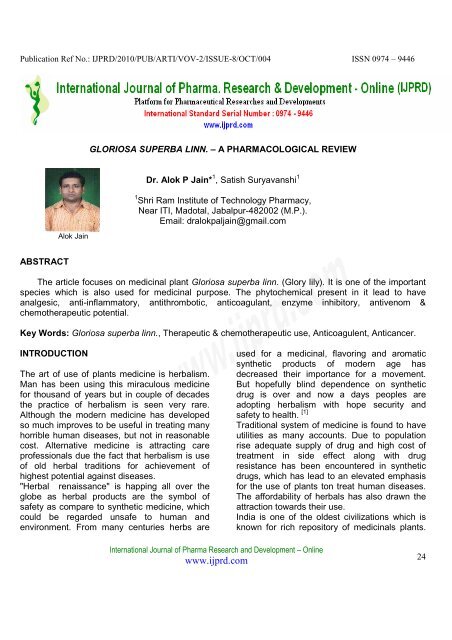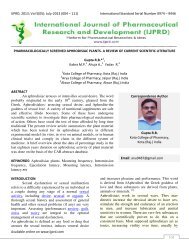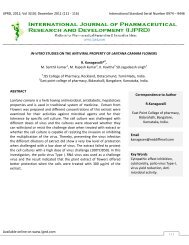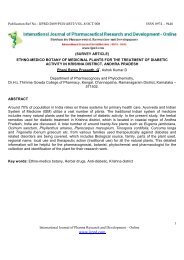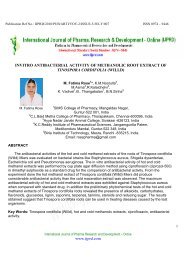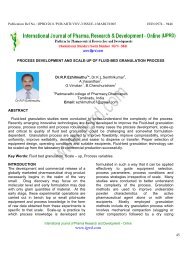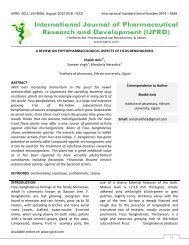gloriosa superba linn. – a pharmacological review - International ...
gloriosa superba linn. – a pharmacological review - International ...
gloriosa superba linn. – a pharmacological review - International ...
Create successful ePaper yourself
Turn your PDF publications into a flip-book with our unique Google optimized e-Paper software.
Publication Ref No.: IJPRD/2010/PUB/ARTI/VOV-2/ISSUE-8/OCT/004 ISSN 0974 – 9446<br />
ABSTRACT<br />
Alok Jain<br />
GLORIOSA SUPERBA LINN. – A PHARMACOLOGICAL REVIEW<br />
Dr. Alok P Jain* 1 , Satish Suryavanshi 1<br />
1 Shri Ram Institute of Technology Pharmacy,<br />
Near ITI, Madotal, Jabalpur-482002 (M.P.).<br />
Email: dralokpaljain@gmail.com<br />
The article focuses on medicinal plant Gloriosa <strong>superba</strong> <strong>linn</strong>. (Glory lily). It is one of the important<br />
species which is also used for medicinal purpose. The phytochemical present in it lead to have<br />
analgesic, anti-inflammatory, antithrombotic, anticoagulant, enzyme inhibitory, antivenom &<br />
chemotherapeutic potential.<br />
Key Words: Gloriosa <strong>superba</strong> <strong>linn</strong>., Therapeutic & chemotherapeutic use, Anticoagulent, Anticancer.<br />
INTRODUCTION<br />
The art of use of plants medicine is herbalism.<br />
Man has been using this miraculous medicine<br />
for thousand of years but in couple of decades<br />
the practice of herbalism is seen very rare.<br />
Although the modern medicine has developed<br />
so much improves to be useful in treating many<br />
horrible human diseases, but not in reasonable<br />
cost. Alternative medicine is attracting care<br />
professionals due the fact that herbalism is use<br />
of old herbal traditions for achievement of<br />
highest potential against diseases.<br />
"Herbal renaissance" is happing all over the<br />
globe as herbal products are the symbol of<br />
safety as compare to synthetic medicine, which<br />
could be regarded unsafe to human and<br />
environment. From many centuries herbs are<br />
<strong>International</strong> Journal of Pharma Research and Development – Online<br />
www.ijprd.com<br />
used for a medicinal, flavoring and aromatic<br />
synthetic products of modern age has<br />
decreased their importance for a movement.<br />
But hopefully blind dependence on synthetic<br />
drug is over and now a days peoples are<br />
adopting herbalism with hope security and<br />
safety to health. [1]<br />
Traditional system of medicine is found to have<br />
utilities as many accounts. Due to population<br />
rise adequate supply of drug and high cost of<br />
treatment in side effect along with drug<br />
resistance has been encountered in synthetic<br />
drugs, which has lead to an elevated emphasis<br />
for the use of plants ton treat human diseases.<br />
The affordability of herbals has also drawn the<br />
attraction towards their use.<br />
India is one of the oldest civilizations which is<br />
known for rich repository of medicinals plants.<br />
24
Publication Ref No.: IJPRD/2010/PUB/ARTI/VOV-2/ISSUE-8/OCT/004 ISSN 0974 – 9446<br />
The forest of India is Pandora's box being<br />
having rich collection of medicinal and aromatic<br />
plants which could be utilize to prepare drugs<br />
and perfumes. Ayurvada, the bible of Indian<br />
medicinal science has codified about 8000<br />
herbal remedies used for various therapeutic<br />
purposes. the other ancient epical health books<br />
like, The Rigveda, Yajurveda, Atharvaveda,<br />
Charak Samhita and Sushrut Samhita has<br />
described the use of various medicinals plants<br />
which are steel found in many of ayurvedic<br />
formulations. But unfortunatly a lot of valuable<br />
ancient knowledge is being lost in alarming rate.<br />
Green plants are biosynthesize and preserve a<br />
large number of biochemical products, many of<br />
which are extractable and used for various<br />
scientific investigations. Secondary metabolites<br />
of plants showed number of role in modern<br />
medicine. it is the potential of ancient herbal<br />
medicinal system which provide base to<br />
synthesis of lead structures for the development<br />
of modified derivatives with increased efficiency<br />
and/or reduced toxicity.<br />
Some miraculous useful chemical from plants<br />
include vinblastine, vincristine, taxol,<br />
podophyllotoxin, camptothecin, digitoxigenin,<br />
gitoxigenin, digoxigenin, tubocurarine,<br />
morphine, codeine, aspirin, atropine,<br />
pilocarpine, capscicine, allicin, curcumin,<br />
artemesinin and ephedrine. The crude extract<br />
from medicinal plants could be used as medica<br />
ment. On the other side, the isolation and<br />
identification of active principle along with<br />
elucidation of their mechanism of action of drug<br />
is of extreme importance. [2,3]<br />
Gloriosa <strong>superba</strong> is one of the oldest ingredient<br />
of species from ancient time. Being native form<br />
Indian specially Southern India it is known as<br />
glory lily and climbing lily- in English; Karihari- in<br />
Hindi; Langli- in Sanskrit. [4,5]<br />
The plant lies in Phyllum – Gimnospermae,<br />
Class – Liliposida and Genus – Gloriosa,<br />
herbaceous, tall with tendril, rootstock are solid,<br />
flaeshy and cylindric, naked & v-shaped.<br />
<strong>International</strong> Journal of Pharma Research and Development – Online<br />
www.ijprd.com<br />
The genous <strong>gloriosa</strong> as is comprised of 8-15<br />
species which include, Gloriosa <strong>superba</strong> Linn,<br />
G luteo, G plantii, G.latifolia, G magnifica,G<br />
rothschildiana, G abysstinica, G longifolia, G<br />
simplex. [6,7]<br />
CHEMICAL CONSTITUENTS<br />
A wide varieties of phytochemicals are found in<br />
glory lily. In the world market glory lily<br />
considered as rich source of colchicines and<br />
gloriosine. Silosterol, its Glucoside and beta and<br />
Gamma Lumicolichicines. Beta silosterol, its<br />
Flucoside and 2-H-6-MeO benzoic acid.<br />
(Table No. 01)<br />
Table: 1- Chemical constituents of plant. [7,8,9,10]<br />
The tubers or dried roots contain colchicines,<br />
benzoic and salicylic acid, sterols and resinous<br />
substances-colchicines, 3-demethyl colchicine,<br />
1,2-didemethyl colchicine, 2,3- didemethyl<br />
colchicine, N-formyl, N-deacetyl colchicines,<br />
colchicocide, gloriosine, tannins and superbine.<br />
[11]<br />
Tubers roots and seeds are two most important<br />
part of glory lily used for variety of purpose. The<br />
roots are digged, washed thoroughly, dried and<br />
store properly for further use. Seed and pericarp<br />
are separated and dried in shade later in<br />
sunlight to dry completely.<br />
Glory lily is also known for its colchicine content<br />
which finds used to treat arthritis, therefor glory<br />
lily is plant of choice for isolation of colchicine. [6]<br />
25
Publication Ref No.: IJPRD/2010/PUB/ARTI/VOV-2/ISSUE-8/OCT/004 ISSN 0974 – 9446<br />
Fig. (1). Structure of colchicine (N-[(7S)-1,2,3,<br />
10- tetramethoxy-9-oxo-5,6,7,9-tetrahydrobenzo<br />
[a]heptalen- 7-yl]acetamide). [12]<br />
TRADITIONAL & MODERN USES AND<br />
APPLICATIONS<br />
Ethanopharmacologyis the branch which deals<br />
with the study of knowledge of herbal practices<br />
among different tribals and rural comnmunities.<br />
(Table No. 02 & Table No. 03)<br />
Table: 2- Medicinal use according to<br />
Communities. [7]<br />
Table: 3- Medicinal use according to literature.<br />
[7]<br />
PHARMACOLOGICAL ACTITVIES<br />
REPORTED OF GLORY LILY<br />
Analgesic and anti-inflammatory potential<br />
Gloriosine and colchicine are two commonly<br />
used phytochemicals for treatment of gout &<br />
rheumatism. The hydroalcohlic extract also<br />
showed analgesic activity when evaluated by<br />
Eddy’s hot plate and acetic acid-induced<br />
writhing studies. Maximum effects were seen in<br />
cotton wool granuloma and carrageenaninduced<br />
paw edema model. [13]<br />
Chemotherapeutic potential<br />
• Antimicrobial properties –<br />
The methanolic extract and subsequent<br />
fraction of glory lily has shown promising<br />
antibacterial and antifungal potential.<br />
Excellent antifungal sensitivity of glory lily<br />
has been reported against Candida<br />
albicans and Candida glaberata. [14]<br />
Aqueous and alcoholic extracts of leaves<br />
also showed significant antimicrobial and<br />
antifungal activity. [15]<br />
Phytochemicals from root tubers have wide<br />
spectrum against Gram-positive and<br />
Gram-negative along with antifungal and<br />
mutagenic potential. The phytochemicals<br />
from tubers has passed Ames Salmonella<br />
<strong>International</strong> Journal of Pharma Research and Development – Online<br />
www.ijprd.com<br />
mutagenicity test due to presence<br />
colchicines. [11]<br />
• Antipoxviral potential –<br />
The presence of mannose derivative and<br />
oligomannose carbohydrates has shown<br />
inhibition against (alpha1-4)Man lectin. It<br />
has also been found cytotoxic to BSC-I cell<br />
line. [16]<br />
• Larvicidal potential –<br />
When evaluated against adult cattle tick,<br />
malaria vector larvae, the various extract of<br />
glory lily showed inhibition of parasite in<br />
crude form. [17]<br />
Also various fraction passed mosquito cytogenic<br />
assay due to colchicines like activity. [18]<br />
Thus glory lily is formed to have potential to be<br />
used as an ideal ecofriendly parasite controlling<br />
effect. [19]<br />
Antithrombotic/Antcoagulent potential<br />
Methanolic and aqueous extract of glory lily has<br />
displayed anticoagulant property which may be<br />
due to inhibition of thrombin induced clotting. [20]<br />
Antitumor potential<br />
The various extracts of glory lily have been<br />
found to certain cytogenic potential when<br />
studied under P-388 cell lines. [21]<br />
Enzyme inhibition potential<br />
The various extracts of glory lily have been<br />
screened and found to have inhibitory effects<br />
against lipoxygenase, acetylcholinesterase,<br />
butyrylcholinesterase and ureas. [22]<br />
Treatment of snake bite<br />
Various fractions of glory lily have proved to<br />
have potent neutralizing effect of rattlesnake<br />
venom, when administered subcutaneously to<br />
mice. [23]<br />
Other uses<br />
• Skin disease – Glory lily extract has<br />
been found to be useful against many<br />
skin diseases. [24]<br />
• Respiratory disorders – It is one of the<br />
useful plant to treat various respiratory<br />
disorders. [25]<br />
26
Publication Ref No.: IJPRD/2010/PUB/ARTI/VOV-2/ISSUE-8/OCT/004 ISSN 0974 – 9446<br />
• Against Familial Mediterranean Fever<br />
(FMF) - Colchicines from glory lily has<br />
been found to prevent activation of<br />
neutrophills, binding β-tubulin and<br />
prevent assembly of microtubules thus<br />
found in FMF. [12]<br />
CONCLUSION<br />
The wide spread use of glory lily as<br />
chemotherapeutic, antitumour and various other<br />
disorders has lead a scientific approach towards<br />
its use as medicinal plants.<br />
REFERENCES:<br />
1. Acharya, Deepak, Shrivastava A,<br />
Indigenous Herbal Medicines: Tribal<br />
Formulations and Traditional Herbal Practices,<br />
Aavishkar Publishers Distributor, Jaipur- India,<br />
ISBN 978-81-7910-252-7, 2008, 440.<br />
2. Joy PP, Thomas J, Mathew S, Skaria<br />
BP, Medicinal Plants Tropical Horticulture,<br />
eds.(Bose TK, Kabir J, Das P, Joy PP), 2, Naya<br />
Prakash, Calcutta, 2001, 449-632.<br />
3. Balandrin MJ, Klocke JA, Medicinal,<br />
aromatic and industrial materials from plants,<br />
ed. by Bajaj YPS Biotechnology in Agriculture<br />
and Forestry, Medicinal and Aromatic Plant, 4,<br />
Springer-Verlag, Berlin, Heidelberg, 1988, 1-36.<br />
4. Nadkarni KM, Indian Matreia Medica, 3rd<br />
ed., Mumbai Popular Prakashan, 1996, 579.<br />
5. Kirthikar KR, Basu BD, Indian medicinal<br />
plant, 2nd ed., Allahabad Popular Publication,<br />
1935, 2525-6.<br />
6.<br />
http://www.tnsmpb.tn.gov.in/images/GLO<br />
RIOSA%20SUPERBA%20Linn.pdf.<br />
7.<br />
http://www.hort.purdue.edu/newcrop/CropFactS<br />
heets/<strong>gloriosa</strong>.html.<br />
8. Capraro HG, Brossi A, In the alkaloids.<br />
(Ed.): A. Brossi. Academic Press, 23, 1984, 1-<br />
70.<br />
<strong>International</strong> Journal of Pharma Research and Development – Online<br />
www.ijprd.com<br />
9. Srivastava UC, Chandra V, Gloriosa<br />
<strong>superba</strong> Linn. (kalihari) - An important<br />
colchicines, 1977.<br />
10. Clewer HWV, Green SS, Tutin F, The<br />
constituents of Gloriosa <strong>superba</strong>, J. Chem.<br />
Soc., 107, 1915, 835–846.<br />
11. Shanmugam H, Rathinam R,<br />
Chinnathambi A,Venkatesan T, Antimicrobial<br />
and mutagenic properties of the root tubers of<br />
<strong>gloriosa</strong> <strong>superba</strong> <strong>linn</strong>. (Kalihari), Pak. J. Bot.,<br />
41(1), 2009, 293-299.<br />
12. Cerquaglia C, Diaco M, Nucera G,<br />
Regina ML, Montalto M, Manna R,<br />
Pharmacological and Clinical Basis of<br />
Treatment of Familial Mediterranean Fever<br />
(FMF) with Colchicine or Analogues: An<br />
Update, Current Drug Targets - Inflammation &<br />
Allergy, 4, 2005, 117-124.<br />
13. Jomy J, Jennifer F, Tanaji N, Samir N,<br />
Alok S, Pradeep D, Analgesic and antiinflammatory<br />
activities of the hydroalcoholic<br />
extract from Gloriosa <strong>superba</strong> Linn.,<br />
<strong>International</strong> Journal of Green Pharmacy, 2009,<br />
215-219.<br />
14. Haroon K, Murad AK, Tahira M,<br />
Muhammad IC, Antimicrobial activities of<br />
Gloriosa <strong>superba</strong> Linn (Colchicaceae) extracts,<br />
Journal of enzyme inhibition and medicinal<br />
chemistry, 2008.<br />
15. Subhasini R, Manimaran S, Ruckmani K,<br />
Antimicrobial activity of aqueous and alcoholic<br />
extracts of leaves of Gloriosa <strong>superba</strong> <strong>linn</strong>.,<br />
Proc lnt. Congress on “Ayurveda-2000”, 216.<br />
16. Amandeep K, Sukhdev SK, Jatinder S,<br />
Rajinder S, Melissa A, Girish JK, Saxena AK,<br />
Purification of 3 monomeric monocot mannosebinding<br />
lectins and their evaluation for<br />
antipoxviral activity: potential applications in<br />
multiple viral diseases caused by enveloped<br />
viruses, Biochemistry and cell biology =<br />
Biochimie et biologie cellulaire, 85(1), 2007, 88-<br />
95.<br />
17. Bagavan A, Kamaraj C, Elango G,<br />
Zahir AA, Rahuman AA, Adulticidal and<br />
larvicidal efficacy of some medicinal plant<br />
27
Publication Ref No.: IJPRD/2010/PUB/ARTI/VOV-2/ISSUE-8/OCT/004 ISSN 0974 – 9446<br />
extracts against tick, fluke and mosquitoes, Veterinary parasitology, 2009.<br />
18. Choochote W, Rongsriyam K, Pitasawat<br />
B, Jitpakdi A, Rattanachanpichai E, Junkum A,<br />
Tuetun B, Chaiwong P, Evaluation of the<br />
colchicine-like activity of Gloriosa <strong>superba</strong>extracted<br />
fractions for mosquito (Diptera:<br />
Culicidae) cytogenetic study, Journal of medical<br />
entomology, 41(4), 2004, 672-6.<br />
19. Zahir A, Rahuman A, Kamaraj C,<br />
Bagavan A, Elango G, Sangaran A, Kumar B,<br />
Laboratory determination of efficacy of<br />
indigenous plant extracts for parasites control,<br />
Parasitology research, 2009.<br />
20. Nalise Low AK, Nandipha M, Hajierah D,<br />
Ryno JN, Carminita LF,<br />
Antithrombotic/anticoagulant and anticancer<br />
activities of selected medicinal plants from<br />
South Africa, African Journal of Biotechnology,<br />
(ISSN: 1684-5315) , 7(2).<br />
21. Chulabhorn M, Somsak R, Hunsa P,<br />
Somchai P, Surang E, Phannipha C, Tasanee<br />
TABLES<br />
Table: 1- Chemical constituents of plant. [7,8,9,10]<br />
<strong>International</strong> Journal of Pharma Research and Development – Online<br />
www.ijprd.com<br />
T, Stitaya S, Porntipa P, Biodiversity and<br />
natural product drug discovery, Pure 81 Appl.<br />
Chem., 70(11), 2065-2072, 1988.<br />
22. Haroon K, Murad AK, Iqbal H, Enzyme<br />
inhibition activities of the extracts from rhizomes<br />
of Gloriosa <strong>superba</strong> Linn (Colchicaceae),<br />
Journal of enzyme inhibition and medicinal<br />
chemistry, 22(6), 2008, 722-5,.<br />
23. Ramar PS, Maung MT, Ponnampalam G,<br />
Savarimuthu I, Ethnobotanical survey of folk<br />
plants for the treatment of snakebites in<br />
Southern part of Tamilnadu, India, Journal of<br />
ethnopharmacology, 115(2), 2008, 302-12.<br />
24. Radha AKG, Siddha herbs exclusively<br />
used in skin diseases.<br />
25. Garima GP, Prashant YM, Vijay VB, Folk<br />
remnedies used against respiratory disorders in<br />
Jalgaon district, Maharashtra, Natural Product<br />
Radiance, 7(4), 2008, 345-358.<br />
S.<br />
No.<br />
PLANT PARTS CHEMICAL CONSTITUENTS<br />
1. Plant Cornigerine,3-demethyl-N-formyl-N-deacetyl-blumicolchicine,<br />
3-demethyl-g-lumicolchicine, 3demethyl<br />
colchicines.<br />
2. Fresh tubers<br />
root<br />
Colchicine, b-sitosterol, its glucoside, a long chain<br />
fatty acid, b and g-lumiccolchicines, 2-0H-6-MeO<br />
benzoic acid.<br />
3. Seed High level of colchicines.<br />
4. Young leaf Cholidonic acid.<br />
5. Flower Luterlin and its glucosides, N-formyl-de-Ac-colchicine,<br />
lumicolchicine.<br />
28
Publication Ref No.: IJPRD/2010/PUB/ARTI/VOV-2/ISSUE-8/OCT/004 ISSN 0974 – 9446<br />
Table: 2- Medicinal use according to Communities. [7]<br />
S.No. COMMUNITIES PLANT<br />
PARTS<br />
USES<br />
1. Ethnic Communities of Root Gout, stomachache and as<br />
North-East India<br />
tonic.<br />
2. Munda and Oraon Tuber Antifertility purpose.<br />
3. Santal (i)Tuberous<br />
root.<br />
(ii) Plant<br />
4. Ethnic Communities of<br />
Bihar<br />
Abortion purpose, in intermittent<br />
fevers, wounds.<br />
Spleen<br />
tumours.<br />
complaints, syphilis,<br />
iii) Leaf Asthma.<br />
Root Cholera, to facilitate childbirth.<br />
5. Ethnic<br />
Orissa<br />
Communities of Tuber Abortifacient.<br />
6. Tribes of Varanasi Root Gout.<br />
7. Tribes of Pithoragarh Tuber Gonorrhoea, leprosy, piles.<br />
8. Ethnic Communities of<br />
Dehra Dun and Siwalik<br />
9. Ethnic Communities of<br />
Garhwal<br />
Root Anthelmintic.<br />
Tuberous<br />
root<br />
Abortion.<br />
Table: 3- Medicinal use according to literature. [7]<br />
S.No. SOURCE OF PLANT<br />
USES<br />
LITERATURE<br />
PARTS<br />
1. Charaka Samhita Plant Useful in itching, skin diseases<br />
including wounds and ailments<br />
caused by vitiated kapha<br />
2. Sushruta Samhita Root<br />
(phlegm) and vata (wind).<br />
Can be administered to a<br />
delivered mother along with<br />
spirituous drink to give relieve<br />
to her postnatal complaints.<br />
3. Rajanighantu Plant Parts It is pungent, thermogenic,<br />
eliminates deranged kapha<br />
(phlegm) and vata (wind),<br />
4. Dhanvantari Nighantu Plant Parts<br />
terminates pregnancy.<br />
In addition to the above, it is<br />
also useful in dropsy, labour<br />
<strong>International</strong> Journal of Pharma Research and Development – Online<br />
www.ijprd.com<br />
25
Publication Ref No.: IJPRD/2010/PUB/ARTI/VOV-2/ISSUE-8/OCT/004 ISSN 0974 – 9446<br />
pain, wounds, and as a<br />
purgative.<br />
5. Madanadi Nighantu Plant Parts It is bitter, pungent,<br />
thermogenic, abortifacient,<br />
removes abdominal pain,<br />
expels the placenta, cures<br />
phlegm, skin diseases.<br />
6. Bhavaprakasha Plant Parts It is apperient, alkaline,<br />
astringent, pungent, bitter,<br />
highly potent, light,<br />
abortifacient, helps storing up<br />
energy, excites pitta (bile), it<br />
cures dropsy, piles, wounds,<br />
acute spasmodic pain, and<br />
7. Chakradatta Root-paste<br />
8. Ayurveda (i) Roots.<br />
ii) Rootpaste.<br />
(iii)Leaf-juice<br />
…End…<br />
removes worms.<br />
<strong>International</strong> Journal of Pharma Research and Development – Online<br />
www.ijprd.com<br />
If smeared over' the palms<br />
and feet of a pregnant woman,<br />
delivery of child becomes<br />
easier.<br />
Abortifacient, acrid, alexiteric,<br />
anthelmintic, antipyretic, bitter,<br />
depurative, digestive, emetic,<br />
expectorant, gastrointestinal<br />
irritant, highly poisonous,<br />
purgative, rejuvenating,<br />
stomachic, thermogenic, tonic,<br />
beneficial in vitiated conditions<br />
of kapha (phlegm) and vata<br />
(wind). debility, dyspepsia,<br />
flatulence, haemorrhoids,<br />
helminthiasis, inflammations,<br />
in promoting labour pain and<br />
expulsion of the placenta.<br />
Effective against paralysis,<br />
rheumatism, snake bite, insect<br />
bites.<br />
Effective against lice.<br />
26


